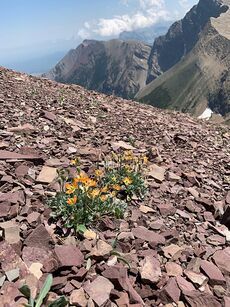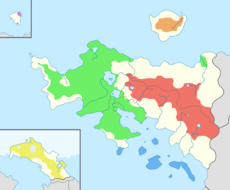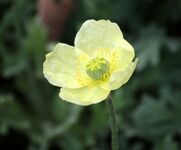Huelrosa: Difference between revisions
No edit summary |
No edit summary |
||
| Line 5: | Line 5: | ||
| colspan="2" align="center" |[[File:Highlands poppy view.jpg|230px]] | | colspan="2" align="center" |[[File:Highlands poppy view.jpg|230px]] | ||
|- | |- | ||
| colspan="2" align="center" | | | colspan="2" align="center" |Bundle of highlands poppies near Mt. Baghdad | ||
|- | |- | ||
| colspan="2" style="padding: 1.5px; background-color: #CDF8B7; text-align: center; vertical-align: middle; font-size: 110%;" |'''Most at risk''' | | colspan="2" style="padding: 1.5px; background-color: #CDF8B7; text-align: center; vertical-align: middle; font-size: 110%;" |'''Most at risk''' | ||
| Line 50: | Line 50: | ||
| colspan="2" align="center" |[[File:Huelrosa range map.png|230x230px]] | | colspan="2" align="center" |[[File:Huelrosa range map.png|230x230px]] | ||
|- | |- | ||
| colspan="2" align="center" | | | colspan="2" align="center" |''Huelrosa'' ranges: {{Color box|#6df068}} Frost; {{Color box|#f07568}} Highlands; {{Color box|#de68f0}} Island golden; {{Color box|#f0ac68}} Mt. James; {{Color box|#f0f068}} Nectar-of-the-north; {{Color box|#68b3f0}} Treynor | ||
|- | |- | ||
| colspan="2" align="center" style="padding: 1.5px; background-color: #CDF8B7; text-align: center; vertical-align: middle; font-size: 110%;" |'''Species''' | | colspan="2" align="center" style="padding: 1.5px; background-color: #CDF8B7; text-align: center; vertical-align: middle; font-size: 110%;" |'''Species''' | ||
Revision as of 02:35, 30 July 2023
| Huelrosa | |

| |
| Bundle of highlands poppies near Mt. Baghdad | |
| Most at risk | |
| Huelrosa insulaaureus É.Dubois, 1552 AN | |

| |
| Vulnerable (MUNHC) | |
| Scientific classification | |
| Kingdom: | Plantae |
| Clade: | Tracheophytes |
| Clade: | Angiosperms |
| Clade: | Eudicots |
| Order: | Ranunculales |
| Family: | Papaveraceae |
| Subfamily: | Papaveroideae |
| Tribe: | Papavereae |
| Genus: | Huelrosa É.Dubois, 1552 AN |
| Type species | |
| Huelrosa borealis B.Frost, 1498 AN | |

| |
| Huelrosa ranges: Frost; Highlands; Island golden; Mt. James; Nectar-of-the-north; Treynor | |
| Species | |
| |
Huelrosa, commonly known as the Meckelnish poppies, is a genus of boreal flowering plants exclusive to the territories of the Kingdom of Meckelnburgh and neighboring frontierlands. Classified under the poppy family, Papaveraceae, it belongs to the subfamily Papaveroideae, along with several other genera of the poppy flower. These plants are perennial and grow from 9 to 60 cm in height, displaying vibrant flowers with four to six petals in shades of orange, yellow, white and cream.
Distribution
The distribution of Huelrosa is restricted to Meckelnburgh proper, Salem and Iselande, as well as adjoining sections of bordering nations. It is native within its entire range. Huelrosa is distributed in all through:
- Genevelond Peninsula
- Treynor Archipelago
- Glanurchy Island
- Fifty Elk Island
- Jääland Peninsula
As hardy perennials, Huelrosa plants are well-suited to the climate of Meckelnburgh, and their attractive flowers serve as a resource for pollinators like bees and butterflies, contributing to their reproductive success. It can be found in various habitats such as rocky mountain outcrops, insular meadow fields, and polar glaciers, but requires well-drained soils and partial to full sun. The genus has adapted to different ecological niches within its range, showcasing six diverse species.
Species
Frost poppy
Huelrosa borealis — arctic poppy, frost poppy, ice poppy, B.Frost, 1498 AN
The frost poppy is found in the warmer lowland regions of Meckelnburgh, though adapted to the common snowy conditions. It is the most common Huelrosa, and is found throughout the Koranga Plains of the Cumberland province in western Meckelnburgh, down through the capital Alexandretta and onto the Siegrwang Peninsular in the south. The stems of H. borealis grow upwards of 30–60 cm in height, with hairy stems. Its petals appear yellow or soft white, hence the namesake of "frost." The frost poppy prefers meadowlands and open plains.
Eastern frost poppy
Huelrosa borealis subsp. orientalis — eastern frost poppy, E.Janssen, 1594 AN
The eastern frost poppy is found along the lower River Tscheid in eastern Meckelnburgh, in the Brittnay province. The yellow blooms of H. b. subsp. orientalis were thought to be a separate species until the 1590s AN. While capable of interbreeding, it is slightly smaller in size, reaching 25–45 centimeters with smooth stems. The eastern frost poppy's range is nonetheless far distant from its nominotypical relations.
Highlands poppy
Huelrosa montana — highlands poppy, B.Helgason, 1605 AN
The highlands poppy is native to the rocky highlands and mountain slopes in Meckelnburgh, with its range throughout the Comstokia Mountains of central and east-central Meckelnburgh. However, some populations range around the Dagora River in western Meckelnburgh. H. montana is most commonly found in areas above 500 meters in elevation. It thrives better on the southern slopes of the Comstokias, in The Clanlands province, where more temperate continental and ocean-moderated rains provide a more forgiving climate.
The stems of the highlands poppy are the shortest, only 9–15 cm. Its petals are brightly bicolored, appearing orange at the tips and blending to yellow by the pistil. H. montana thrives in rocky soils prevalent in the alpine regions, often found on steep slopes and rocky outcrops.
Island golden poppy
Huelrosa insulaaureus — island golden poppy, É.Dubois, 1552 AN
The island golden poppy is the rarest of Huelrosa species, found only on Fifty Elk Island in the Prince-Archabbacy of Salem, off the coast of Lac Glacei in the Northern Sea. The stems of H. insulaalba reach a height of 30–40 cm, with petals of vivid yellow. The island golden poppy thrives in the wetlands of the island.
Mt. James poppy
Huelrosa volcana — Mt. James poppy, volcano poppy, E.Janssen, 1589 AN
The Mt. James poppy occurs on Mt. James, a semi-active volcano in Meckelnburgh, which is the source of Glanurchy Island in the Palatinate of Hergilsey. H. volcana thrives in volcanic soils and can be found on the rocky slopes of Mt. James, in and about the ice-free portions of the volcano's slopes. The stems of the Mt. James poppy reach a height of 12–18 cm, with flowers that show in buff cream or yellow-green. H. volcana is adapted to the extreme temperature variations possible across Glanurchy Island. The Mt. James poppy is also heliotropic, growing to face the direction of sunlight.
Nectar-of-the-north poppy
Huelrosa polarnectaris — nectar-of-the-north poppy, T.Järvinen, 1610 AN
The nectar-of-the-north poppy is the most northernmost of Huelrosa and is native to the polar regions of the Grand Duchy of Iselande, primarily on the permanent tundra and glaciers in the north of the Jääland Peninsula. The stems of H. polarnectaris grow to 15–35 cm in height while its petals appear pale white to a light lime green. The nectar-of-the-north poppy thrives on the tundra and around glaciers, often found in areas with permafrost.
Treynor poppy
Huelrosa archipelagica — Treynor poppy, A.Helgason, 1608 AN
The Treynor poppy is native to the Treynor Archipelago, lying in the south of Meckelnburgh in Crowsilver Bay, on the edge of Tallandor Bay. Its range has also been known to extend in small blooms around the city of Victoria on the Siegrwang Peninsular. The stems of H. archipelagica have a height of 10–25 cm and its petals appear yellow to lime green. The Treynor poppy thrives in sandy, gravel, and clay soils along coastal headlands and hillsides throughout the archipelago.
Conservation
Due to its wide distribution, Huelrosa faces mild conservation challenges, but is nonetheless affected by human activities, including habitat destruction from logging or other resource-extraction industries, particularly the highlands poppy in the Comstokia Mountains. The rarest, the island golden poppy, lives in a narrow habitat on Fifty Elk Island, facing intrusion by the expanding built environment of the monasteries under the archabbacy of Salem.
Huelrosa is nonetheless protected in the royal preserves, forests and other conservation areas throughout Meckelnburgh.
Culture
Apart from their ecological importance, Huelrosa flowers hold cultural significance in Meckelnburgh, often featuring in traditional festivals and ceremonies, symbolizing beauty, resilience, and the nation's natural heritage. The highlands poppy, H. montana, is the national flower of Meckelnburgh, and adorns countless gardens and ceremonies kingdom-wide. Artists and poets draw inspiration from these blooms, further highlighting their role in the country's cultural identity.






